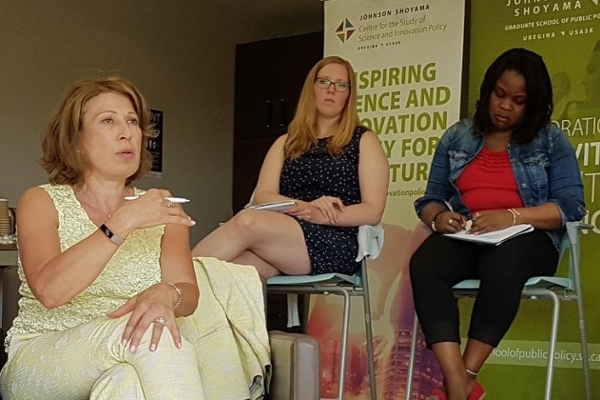
The Science - Public Policy Dilemma
A discussion with Dr. Mona Nemer, Chief Science Advisor to Canada’s Prime Minister, Minister of Science and Cabinet
By Peter W.B. Phillips, CSIP Research Lead and JSGS Distinguished Professor; Yvonne Ndelle, PhD CandidateThere is an active tug-of-war between policymakers and scientists about where and how science should be situated in government. Generally speaking, governments are engaged in both setting policy for science and mobilizing science for policy. Most large and pressing public issues (climate change, health policy, public safety) need science and scientists. As well, most quality of life concerns at root involve the science of natural or built systems. Scientists have critical insights into the scale and scope of problems, the causal relationships that drive choices and the feasible alternatives and their likely impacts. But in a democracy, scientists cannot have the final say. What we choose to prioritize, how we engage and what we want to accomplish are matters of public choice. The question is how to effectively engage—as Churchill used to say, should scientists be on tap or on top? Dr. Mona Nemer, the recently appointed Chief Science Advisor to the Government of Canada, has the herculean challenge of helping to manage that uneasy relationship. In July 2019 Dr. Nemer visited CSIP and engaged in a wide-ranging discussion about science for policy and policy for science in Canada. Dr. Nemer’s mandate is to provide advice on issues related to science and government policies that support it. This includes advising on ways to ensure that science is considered in policy decisions and that government science is fully available to the public.
The Science – Public Policy Disconnect
Describing the science policy field as complex and multi-layered, Dr. Nemer noted that her mandate is a very challenging one as many scientists are not well-versed on the policy development process in Canada. Dr. Nemer explained that there is no lack of science advice in government, rather there is too much of science advocacy and it is going in all different directions. The increasing silos between science and policy and among government departments need to be addressed, as few centres are working horizontally, sharing or collaborating. The challenge lies in helping people to systematically identify the silos and create some form of engagement with others. The spirit is there, but the mechanism is absent. With focused training within government to enable scientists to understand policy and for policymakers to understand scientific methods, both groups may be empowered to step out of their comfort zone. Dr. Nemer also noted a collective failure to properly describe the very diverse areas that could be exploited with a background in science, including public policy.
Moving Beyond Political Thinking
Speaking on the policy of continuity and how to get foundational policies that support long term work, Dr. Nemer explained that with the right evidence and problem framing, we can find solutions. It is not necessary to completely change what is working. Instead, we have to better contextualize our problems and solutions. Innovation has been facing the problem of non-existence of a larger innovation framework for some time. There needs to be a coherent approach and a framework with some profound thinking about the basic elements and options to be considered when dealing with innovation. There is an outside perception of government as non-objective. This and other factors can lead policymakers and scientists to become process-focused, and unable to see the bigger picture or identify root causes.
When asked about her thoughts on a recent report that asserted that diversity is an influencer of innovative culture, Dr. Nemer observed that Canada is not using enough of the assets that its diversity offers in terms of culture, language, people’s imaginations and the immigrant population. Harnessing these assets and opportunities to improve Canada’s place in the global world, can make us more competitive.
Universities are also crucial in making Canada more competitive in the innovation landscape because they are safe places for hosting difficult conversations. In principle, they are a place that cultivates open-mindedness and encourages dialogue. Not only do they provide a space for a diversity of views, careers, and approaches, but they also offer a broader understanding of a wide range of issues and the ability to navigate various parts of policy or government. Closing the gaps in understanding between communities that need to work together will also require some programs and educational opportunities for students from diverse disciplines. Through open dialogue, universities can help students understand the importance of public policy in science and the value of science for creating better public policy.
The Way Forward?
Moving forward, Dr. Nemer underscored the need for more mobility between sectors, for instance between governments, universities and industry, as well as bringing in more external, impartial advisers to different departments within government. In order to create engagement to break down silos, we need to develop the capacity of some people in and out of government who can be called upon to provide advice quickly. Each ministry could be assigned a science advisor and more avenues of training and mentorship should be opened, such as having scientists in residence, and/or scholars or innovators in residence. The existing mechanisms should be reassessed as many are not utilized.
One of the final questions regarded the communication of science, polarization, and the concept of balanced coverage in journalism. Dr. Nemer proposed that all scholars should assume the responsibility of the communication of their research. This means ensuring it is clearly communicated and put in context. Something radical ought to be done about the way experts interact with the public and with other experts. While critical thinking literacy should be improved to address issues like ‘fake news’, literacy also needs to be developed on many fronts, including science literacy and innovation literacy, so that people can ask the right questions to understand the world around them.

